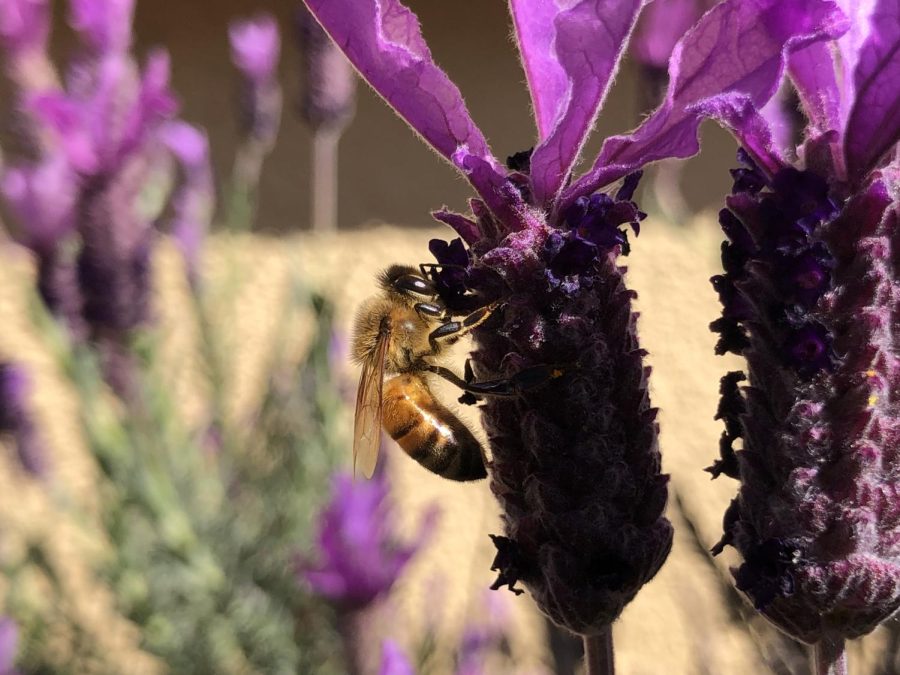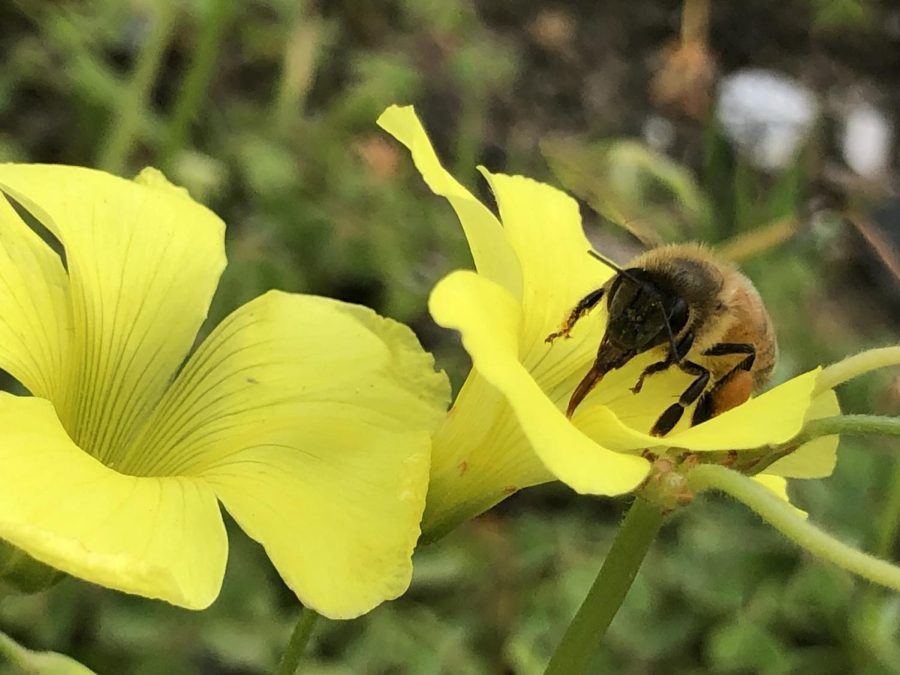As spring begins to bloom, so do flowers, trees, and plants. Take a closer look and see a network of small insects working hard to keep the world alive.
In fact, the entire population relies on a single insect.
Bees.
“About one-third of what we eat is bee-pollinated,” said Tori Muir, a beekeeper at the Beekeepers’ Guild of San Mateo County.
Bees may be small, but the consequences of their decline are not. In the case of bee extinction, the loss of crops would ripple through hundreds of ecosystems, collapsing the self-sufficient nature of our world.
In a study from Rutgers University in 2018, scientists discovered that fruits like apples, cherries, and blueberries were not fully pollinated. Flowers that are not pollinated do not grow fruit. Scientists concluded that declining pollination could directly affect crop yields.
The loss of bees would significantly alter human food systems. According to Britannica: Plant and Environmental Science, human nutrition, reliant on bee-pollinated crops, would suffer. These circumstances could lead to worldwide malnutrition and famines.
“It’s not just ‘a nice idea’ to support bees; it’s crucial to maintaining our agricultural system and the diversity of our food supply,” Muir said.
In a survey conducted by researchers partnered with the Bee Informed organization, scientists discovered that about 31% of beekeepers in California lost colonies from October 2020 to April 2021. If this trend continues, there will be severe ecological consequences.
The issue of bee population decline poses not only an environmental threat but also an economic one. According to a press release from the White House, pollinated crops account for more than $15 billion in the food industry yearly. In 2014, US beekeepers lost $10 million due to declining pollinator populations.
Beekeepers, like Muir, believe many factors could be generating a decrease in pollination and bee populations. These issues contribute to colony collapse disorder, the sudden death of an entire hive of bees. To combat this disorder, beekeepers are working to limit three main threats: changes in habitat, chemicals, and pests.
Changes in Habitat
“For native bees and other pollinators, the major stressor is loss of habitat and forage,” Muir said.
Abundant forage, a bee’s food supply, is essential to sustaining a colony. Limited forage is one of the influences negatively affecting bee populations. The root of this issue began decades ago when farmers left the edges of their land uncultivated. Instead of growing crops, non-flowering weeds spread in this land. This loss of nutritional diversity didn’t give bees enough plants to pollinate.
Students at the University of California, Davis have conducted research demonstrating that planting wildflowers in orchards increases pollination levels.
“Programs are being developed at UC Davis’ entomology department to encourage farmers to set aside some land to grow pollinator-supportive plants that bloom at different times than the main crop,” Muir said.
The lack of forage doesn’t only affect bees in agricultural areas but suburban areas as well. Buildings limit the amount of land available for bees, like bumblebees, that burrow underground. Pollinators receive little to no nutrition in most gardens since many plants, like grass, do not provide nectar or pollen.
Luckily, creating forage for bees is not difficult. Local landscape designer, Kristen Rudger, has identified many native plants that can support pollinators like bees. Flowering plants, especially those with bright purple flowers like lavender and sage, help attract bees.
“There are over 1,000 species of native bees in California. So, growing native plants attracts native bees to your garden. Plants like the sticky monkey-flower, which grows in a canyon near us, California fuchsia, and native sages are great. There are also flowering trees like eucalyptus, acacia trees, and mock orange trees, which I have in my own garden, that attract pollinators,” Rudger said.
Chemicals
Native plants allow people in suburban areas to provide pollinator habitats right in their backyards. However, when maintaining these plants, some choose to use chemical fertilizers to help them grow. Unfortunately, these fertilizers, and many pesticides, are poisonous and pose a threat to pollinators. In particular, systemic pesticides have been the subject of many accusations.
“The chemicals to avoid are systemic pesticides which are often used to treat roses and other flowers. Plants take these chemicals up their stems, and they get dispersed through the nectar,” Rudger said.
Systemic pesticides can be found in insecticides, fungicides, and herbicides. In 2018, the European Parliament voted to ban neonicotinoids, an insecticide derived from nicotine. In the United States, during the Obama administration, restrictions were placed on the use of neonicotinoids in wildlife refuges. However, these restrictions were reversed under the Trump administration. Currently, the Center for Biological Diversity and the Center for Food Safety are actively trying to restore the ban on neonicotinoids. A legal petition, released on Feb. 24, this year, urges President Joe Biden to prohibit using harmful agricultural pesticides.
In the meantime, techniques are being created to avoid chemical-based products. Instead, there are natural strategies that can be used to deter pests. Integrated pest management uses biological science to ward off unwanted bugs.
“This technique stems from the idea that there is an existing natural predator for every pest. So if you attract that predator using plants instead of chemicals, you can naturally get rid of pests,” Rudger said.
Pests
There are three main pests endangering bees: Ants, yellowjackets, and varroa mites. The varroa mite is one of the most dangerous and one of the primary contributors to bee population decline. Varroa mites can transmit diseases by sucking out bees’ hemolymph.
“Beekeepers have differing opinions on whether it’s better to treat bee colonies for the mites or use natural selection to develop mite-resistant bees, so there are efforts ongoing in multiple directions,” Muir said.
The University of Warwick, School of Life Sciences, has discovered that the varroa mite is vulnerable to entomopathogenic fungi. Various experiments have proven that this fungus kills varroa without harming bees. Scientists are now researching how to formulate these fungi into usable products.
Blagoja Golubovski, a local beekeeper and owner of Belmont Beelicious, has observed the three main pests throughout his experience with bees. He noticed ants damaging beehives because they go after honey and disrupt the bees’ work.
“To avoid ants, beekeepers place legs on their hives to raise them off the ground. They also put water, tape, or chalk to block the ants from going up to the hive. For the yellowjackets, I have traps all over my backyard, where the bees are. I have seven of them, and they get full in only a few months,” Golubovski said.
The increase in yellowjackets across the Bay Area may be linked to the drought. According to the San Mateo County Mosquito and Vector Control District, yellowjacket removal requests increase in the summer when warm weather increases wasp activity. The dry weather in California has increased this activity because the rain, which typically washes away yellowjacket nests, has been scarce in the last couple of years.
“I’ve seen the varroa mite, which brings diseases into beehives, cause a whole colony to die out. It’s a big strain on the bee population. Some chemicals can get rid of things, like yellowjackets and varroa, but personally, I don’t use them. My philosophy about beekeeping is that I don’t want to put anything chemically foreign for the bees inside their hives,” Golubovski said.
Honeybees have lived without human intervention for many years. They have adapted to many environmental changes over centuries. So, using ecological techniques, like natural selection, Golubovski is able to combat any threats facing his bees. Natural selection allows weaker bees to die, leaving the healthiest bees to continue growing the hive’s population. Eventually, only the bees who can withstand the selective pressures in the area will remain. The hope for many beekeepers, like Golubovski, is to help bees survive in a changing world.
“An aspect of beekeeping that is enormously rewarding is helping the environment and enabling the bees to do all the amazing things they do in our nature. Our plants and entire vegetation are driven by bees. So, we all benefit from what bees do with pollination,” Golubovski said.
























